Pharmacokinetic Properties of 68Ga-labelled Folic Acid Conjugates: Improvement Using HEHE Tag
Abstract
1. Introduction
2. Results
2.1. Synthesis of Precursors
2.2. Radiolabelling, Stabillity and Distribution Coefficients (LogDow value) Studies
2.3. In Vitro Studies
2.4. In Vivo Studies
2.4.1. Biodistribution in Healthy Animals
2.4.2. Biodistribution in KB-tumor Murine Xenograft Models
3. Discussion
4. Materials and Methods
4.1. Chemicals and Reagents
4.2. 68Ge/68Ga Generator
4.3. Synthesis of NODAGA-1,4-Buthanediamine--Folic Acid (4 in Scheme 1, FA-I)
4.3.1. Synthesis of N--BOC-1,4-Buthanediamine--Folic Acid (1)
4.3.2. Synthesis of 1,4-Butanediamine-Folic Acid (2)
4.3.3. Synthesis of NODAGA(tBu)3–1,4-Butanediamine-Folic Acid (3)
4.3.4. Synthesis of NODAGA-1,4-Butanediamine-Folic Acid (4, FA-I)
4.4. Synthesis of NODAGA-[Lys-(HE)2]--Folic Acid (9 in Scheme 2, FA-II)
4.4.1. Synthesis of Lys-(HE)2 Sequence Bound onto 2-CTC Resin (5)
4.4.2. Synthesis of [Lys-(HE)2]--Folic Acid Bound onto the Resin (6)
4.4.3. Cleavage of [Lys-(HE)2]-Folic Acid from the Resin (7)
4.4.4. Synthesis of NODAGA(tBu)3-[Lys-(HE)2]-Folic Acid (8)
4.4.5. Synthesis of NODAGA-[Lys-(HE)2]-Folic Acid (9, FA-II)
4.5. Preparation and Quality Control of 68Ga-Labeled Compounds
4.6. n-Octanol/Water Distribution Coefficient (LogDow Value)
4.7. Cell Cultures and In Vitro Studies
4.8. Biodistribution Studies
4.9. Statistical Analysis
5. Conclusions
Supplementary Materials
Author Contributions
Funding
Acknowledgments
Conflicts of Interest
References
- Kim, E.E.; Yang, D.J. Targeted Molecular Imaging in Oncology; Springer: New York, NY, USA, 2001; pp. 62–111. [Google Scholar]
- Richter, M.; Zhang, H. Receptor-targeted cancer therapy. DNA Cell Biol. 2005, 24, 271–282. [Google Scholar] [CrossRef] [PubMed]
- Chen, C.; Ke, J.; Edward Zhou, X.; Yi, W.; Brunzelle, J.S.; Li, J.; Yong, E.L.; Xu, H.E.; Melcher, K. Structural basis for molecular recognition of folic acid by folate receptors. Nature 2013, 500, 486–489. [Google Scholar] [CrossRef] [PubMed]
- Muller, C. Folate Based Radiopharmaceuticals for imaging and therapy of cancer and inflammation. Curr. Pharm. Des. 2012, 18, 1058–1083. [Google Scholar] [CrossRef] [PubMed]
- Müller, C. Folate-based radiotracers for PET imaging-update and perspectives. Molecules 2013, 18, 5005–5031. [Google Scholar] [CrossRef] [PubMed]
- Ross, J.F.; Chaudhuri, P.K.; Ratnam, M. Differential regulation of folate receptor isoforms in normal and malignant tissues in vivo and in established. Cancer 1994, 73, 2432–2443. [Google Scholar] [CrossRef]
- Parker, N.; Turk, M.J.; Westrick, E.; Lewis, J.D.; Low, P.S.; Leamon, C.P. Folate receptor expression in carcinomas and normal tissues determined by a quantitative radioligand binding assay. Anal. Biochem. 2005, 338, 284–293. [Google Scholar] [CrossRef]
- Xia, W.; Hilgenbrink, A.R.; Matteson, E.L.; Lockwood, M.B.; Cheng, J.X.; Low, P.S. A functional folate receptor is induced during macrophage activation and can be used to target drugs to activated macrophages. Blood 2009, 113, 438–446. [Google Scholar] [CrossRef] [PubMed]
- de Visser, H.M.; Korthagen, N.M.; Müller, C.; Ramakers, R.M.; Krijger, G.C.; Lafeber, F.P.J.G.; Beekman, F.J.; Mastbergen, S.C.; Weinans, H. Imaging of folate receptor expressing macrophages in the rat groove model of osteoarthritis: Using a New DOTA-folate conjugate. Cartilage 2018, 9, 183–191. [Google Scholar] [CrossRef] [PubMed]
- Scaranti, M.; Cojocaru, E.; Banerjee, S.; Banerji, U. Exploiting the folate receptor α in oncology. Nat. Rev. Clin. Oncol. 2020, 17, 349–359. [Google Scholar] [CrossRef]
- Siegel, B.A.; Dehdashti, F.; Mutch, D.G.; Podoloff, D.A.; Wendt, R.; Sutton, G.P.; Burt, R.W.; Ellis, P.R.; Mathias, C.J.; Green, M.A.; et al. Evaluation of 111in-DTPA-folate as a receptor-targeted diagnostic agent for ovarian cancer: Initial clinical results. J. Nucl. Med. 2003, 44, 700–707. [Google Scholar] [PubMed]
- Fisher, R.E.; Siegel, B.A.; Edell, S.L.; Oyesiku, N.M.; Morgenstern, D.E.; Messmann, R.A.; Amato, R.J. Exploratory study of 99mTc-EC20 imaging for identifying patients with folate receptor-positive solid tumors. J. Nucl. Med. 2008, 49, 899–906. [Google Scholar] [CrossRef] [PubMed]
- Cohen, A.; Douglas, K.; Roller, L.; Fisher, A.; Peterson, T.; Liu, F.; Nickels, M.; Smith, G.; Blackwell, T.; Manning, H.C. First-in-human PET imaging study using [68Ga]-folate tracer, [68Ga]EC2115. J. Nucl. Med. 2019, 60, 1062. [Google Scholar]
- Kessler, R.M.; Seibyl, J.; Cowan, R.L.; Zald, D.; Young, J.S.; Ansari, M.S.; Stabin, M.G. Radiation dosimetry of 18F-FPEB in humans. J. Nucl. Med. 2014, 55, 1119–1121. [Google Scholar] [CrossRef] [PubMed][Green Version]
- Gnesin, S.; Müller, J.; Burger, I.A.; Meisel, A.; Siano, M.; Früh, M.; Choschzick, M.; Müller, C.; Schibli, R.; Ametamey, S.M.; et al. Radiation dosimetry of 18F-AzaFol: A first in-human use of a folate receptor PET tracer. EJNMMI Res. 2020, 10, 32. [Google Scholar] [CrossRef] [PubMed]
- Blackwell, T.S.; Manning, H.C. Imaging Activated Macrophages in the Lungs-Study Record Detail. 31 October 2021 Vanderbilt University Medical Center. Available online: https://clinicaltrials.gov/ct2/show/NCT03494114 (accessed on 24 April 2020).
- Farkas, R.; Siwowska, K.; Ametamey, S.M.; Schibli, R.; Van Der Meulen, N.P.; Müller, C. 64Cu- and 68Ga-based PET imaging of folate receptor-positive tumors: Development and evaluation of an albumin-binding NODAGA-folate. Mol. Pharm. 2016, 13, 1979–1987. [Google Scholar] [CrossRef] [PubMed]
- Radford, L.L.; Fernandez, S.; Beacham, R.; El Sayed, R.; Farkas, R.; Benešová, M.; Müller, C.; Lapi, S.E. New 55Co-labeled albumin-binding folate derivatives as potential PET agents for folate receptor imaging. Pharmaceuticals 2019, 12, 166. [Google Scholar] [CrossRef]
- Schniering, J.; Benešová, M.; Brunner, M.; Haller, S.; Cohrs, S.; Frauenfelder, T.; Vrugt, B.; Feghali-Bostwick, C.; Schibli, R.; Distler, O.; et al. 18F-AzaFol for detection of folate receptor-β positive macrophages in experimental interstitial lung disease—A proof-of-concept study. Front. Immunol. 2019, 10, 2724. [Google Scholar] [CrossRef]
- Choi, P.S.; Lee, J.Y.; Park, J.H.; Kim, S.W. Synthesis and evaluation of 68Ga-HBED-CC-EDBE-folate for positron-emission tomography imaging of overexpressed folate receptors on CT26 tumor cells. J. Label. Compd. Radiopharm. 2018, 61, 4–10. [Google Scholar] [CrossRef]
- Mathias, C.J.; Lewis, M.R.; Reichert, D.E.; Laforest, R.; Sharp, T.L.; Lewis, J.S.; Yang, Z.F.; Waters, D.J.; Snyder, P.W.; Low, P.S.; et al. Preparation of 66Ga- and 68Ga-labeled Ga(III)-deferoxamine-folate as potential folate-receptor-targeted PET radiopharmaceuticals. Nucl. Med. Biol. 2003, 30, 725–731. [Google Scholar] [CrossRef]
- Muller, C.; Bunka, M.; Reber, J.; Fischer, C.; Zhernosekov, K.; Turler, A.; Schibli, R. Promises of cyclotron-produced 44Sc as a diagnostic match for trivalent β--emitters: In vitro and in vivo study of a 44Sc-DOTA-folate conjugate. J. Nucl. Med. 2013, 54, 2168–2174. [Google Scholar] [CrossRef]
- Lehenberger, S.; Barkhausen, C.; Cohrs, S.; Fischer, E.; Grünberg, J.; Hohn, A.; Köster, U.; Schibli, R.; Türler, A.; Zhernosekov, K. The low-energy β - and electron emitter 161Tb as an alternative to 177Lu for targeted radionuclide therapy. Nucl. Med. Biol. 2011, 38, 917–924. [Google Scholar] [CrossRef] [PubMed]
- Low, P.S.; Henne, W.A.; Doorneweerd, D.D. Discovery and development of folic-acid-based receptor targeting for imaging and therapy of cancer and inflammatory diseases. Acc. Chem. Res. 2008, 41, 120–129. [Google Scholar] [CrossRef] [PubMed]
- Müller, C.; Struthers, H.; Winiger, C.; Zhernosekov, K.; Schibli, R. DOTA Conjugate with an albumin-binding entity enables the first folic acid-targeted 177Lu-radionuclide tumor therapy in mice. J. Nucl. Med. 2013, 54, 124–131. [Google Scholar] [CrossRef] [PubMed]
- Hofström, C.; Orlova, A.; Altai, M.; Wangsell, F.; Gräslund, T.; Tolmachev, V. Use of a HEHEHE purification tag instead of a hexahistidine tag improves biodistribution of affibody molecules site-specifically labeled with 99mTc, 111In, and 125I. J. Med. Chem. 2011, 54, 3817–3826. [Google Scholar] [CrossRef]
- Tolmachev, V.; Hofström, C.; Malmberg, J.; Ahlgren, S.; Hosseinimehr, S.J.; Sandström, M.; Abrahmsén, L.; Orlova, A.; Gräslund, T. HEHEHE-tagged affibody molecule may be purified by IMAC, is conveniently labeled with [99mTc(CO)3]+, and shows improved biodistribution with reduced hepatic radioactivity accumulation. Bioconjug. Chem. 2010, 21, 2013–2022. [Google Scholar] [CrossRef]
- Leitao, C.D.; Rinne, S.S.; Mitran, B.; Vorobyeva, A.; Andersson, K.G.; Tolmachev, V.; Ståhl, S.; Löfblom, J.; Orlova, A. molecular design of HER3-targeting affibody molecules: Influence of chelator and presence of HEHEHE-tag on biodistribution of 68Ga-labeled tracers. Int. J. Mol. Sci. 2019, 20, 1–13. [Google Scholar]
- Eder, M.; Löhr, T.; Bauder-Wüst, U.; Reber, M.; Mier, W.; Schäfer, M.; Haberkorn, U.; Eisenhut, M. Pharmacokinetic properties of peptidic radiopharmaceuticals: Reduced uptake of (EH)3-conjugates in important organs. J. Nucl. Med. 2013, 54, 1327–1330. [Google Scholar] [CrossRef][Green Version]
- Liolios, C.; Schäfer, M.; Haberkorn, U.; Eder, M.; Kopka, K. Novel bispecific PSMA/GRPr targeting radioligands with optimized pharmacokinetics for improved PET imaging of prostate cancer. Bioconjug. Chem. 2016, 27, 737–751. [Google Scholar] [CrossRef]
- Baranski, A.C.; Schäfer, M.; Bauder-Wüst, U.; Wacker, A.; Schmidt, J.; Liolios, C.; Mier, W.; Haberkorn, U.; Eisenhut, M.; Kopka, K.; et al. Improving the imaging contrast of 68Ga-PSMA-11 by targeted linker design: Charged spacer moieties enhance the pharmacokinetic properties. Bioconjug. Chem. 2017, 28, 2485–2492. [Google Scholar] [CrossRef]
- Fani, M.; Tamma, M.L.; Nicolas, G.P.; Lasri, E.; Medina, C.; Raynal, I.; Port, M.; Weber, W.A.; Maecke, H.R. In vivo imaging of folate receptor positive tumor xenografts using novel 68Ga-NODAGA-folate conjugates. Mol. Pharm. 2012, 9, 1136–1145. [Google Scholar] [CrossRef]
- Trindade, A.F.; Frade, R.F.M.; MaçÔas, E.M.S.; Graça, C.; Rodrigues, C.A.B.; Martinho, J.M.G.; Afonso, C.A.M. “Click and go”: Simple and fast folic acid conjugation. Org. Biomol. Chem. 2014, 12, 3181–3190. [Google Scholar] [CrossRef] [PubMed]
- Atkinson, S.F.; Bettinger, T.; Seymour, L.W.; Behr, J.P.; Ward, C.M. Conjugation of Folate via Gelonin carbohydrate residues retains ribosomal-inactivating properties of the toxin and permits targeting to folate receptor positive cells. J. Biol. Chem. 2001, 276, 27930–27935. [Google Scholar] [CrossRef] [PubMed]
- Jiang, L.; Zeng, X.; Wang, Z.; Chen, Q. Cell line cross-contamination: KB is not an oral squamous cell carcinoma cell line. Eur. J. Oral Sci. 2009, 117, 90–91. [Google Scholar] [CrossRef] [PubMed]
- Soe, Z.C.; Poudel, B.K.; Nguyen, H.T.; Thapa, R.K.; Ou, W.; Gautam, M.; Poudel, K.; Jin, S.G.; Jeong, J.H.; Ku, S.K.; et al. Folate-targeted nanostructured chitosan/chondroitin sulfate complex carriers for enhanced delivery of bortezomib to colorectal cancer cells. Asian J. Pharm. Sci. 2019, 14, 40–51. [Google Scholar] [CrossRef] [PubMed]
- Chen, H.; Li, S.; Li, B.; Ren, X.; Li, S.; Mahounga, D.M.; Cui, S.; Gu, Y.; Achilefu, S. Folate-modified gold nanoclusters as near-infrared fluorescent probes for tumor imaging and therapy. Nanoscale 2012, 4, 6050–6064. [Google Scholar] [CrossRef]
- Fani, M.; Wang, X.; Nicolas, G.; Medina, C.; Raynal, I.; Port, M.; Maecke, H.R. Development of new folate-based pet radiotracers: Preclinical evaluation of 68Ga-DOTA-folate conjugates. Eur. J. Nucl. Med. Mol. Imaging 2011, 38, 108–119. [Google Scholar] [CrossRef]
- Jain, A.; Mathur, A.; Pandey, U.; Bhatt, J.; Mukherjee, A.; Ram, R.; Sarma, H.D.; Dash, A. Synthesis and evaluation of a 68Ga labeled folic acid derivative for targeting folate receptors. Appl. Radiat. Isot. 2016, 116, 77–84. [Google Scholar] [CrossRef]
- Brand, C.; Longo, V.A.; Groaning, M.; Weber, W.A.; Reiner, T. Development of a new folate-derived Ga-68-Based PET imaging agent. Mol. Imaging Biol. 2017, 19, 754–761. [Google Scholar] [CrossRef]
- Benešová, M.; Bauder-Wüst, U.; Schäfer, M.; Klika, K.D.; Mier, W.; Haberkorn, U.; Kopka, K.; Eder, M. Linker modification strategies to control the prostate-specific membrane antigen (PSMA)-targeting and pharmacokinetic properties of DOTA-conjugated PSMA inhibitors. J. Med. Chem. 2016, 59, 1761–1775. [Google Scholar] [CrossRef]
- Wüstemann, T.; Bauder-Wüst, U.; Schäfer, M.; Eder, M.; Benesova, M.; Leotta, K.; Kratochwil, C.; Haberkorn, U.; Kopka, K.; Mier, W. Design of internalizing PSMA-specific Glu-Ureido-based radiotherapeuticals. Theranostics 2016, 6, 1085–1095. [Google Scholar] [CrossRef]
- Eagle, H. Propagation in a fluid medium of a human epidermoid carcinoma, strain KB. Exp. Biol. Med. 1955, 8, 362–364. [Google Scholar] [CrossRef] [PubMed]
- Larenkov, A.A.; Bruskin, A.B.; Kodina, G.E. Preparation of highly purified 68Ga solutions via ion exchange in hydrochloric acid–ethanol mixtures. J. Radioanal. Nucl. Chem. 2015, 305, 147–160. [Google Scholar] [CrossRef]
- Larenkov, A.; Maruk, A. Radiochemical purity of 68Ga-BCA-peptides: Separation of all 68Ga species with a single ITLC strip. World Acad. Sci. Eng. Technol. Int. J. Chem. Mol. Nucl. Mater. Metall. Eng. 2016, 10, 1120–1127. [Google Scholar]
- Guaragna, A.; Roviello, G.N.; D’Errico, S.; Paolella, C.; Palumbo, G.; D’Alonzo, D. Solid phase synthesis of a novel folate-conjugated 5-aminolevulinic acid methyl ester based photosensitizer for selective photodynamic therapy. Tetrahedron Lett. 2015, 56, 775–778. [Google Scholar] [CrossRef]
- Larenkov, A.A.; Maruk, A.Y.; Kodina, G.E. Intricacies of the determination of the radiochemical purity of 68Ga preparations: Possibility of sorption of ionic 68Ga species on reversed-phase columns. Radiochemistry 2018, 60, 625–633. [Google Scholar] [CrossRef]
- Maruk, A.Y.; Larenkov, A.A. Determination of ionic 68Ga impurity in radiopharmaceuticals: Major revision of radio-HPLC methods. J. Radioanal. Nucl. Chem. 2020, 323, 189–195. [Google Scholar] [CrossRef]
- Kempińska, D.; Chmiel, T.; Kot-Wasik, A.; Mróz, A.; Mazerska, Z.; Namieśnik, J. State of the art and prospects of methods for determination of lipophilicity of chemical compounds. TrAC Trends Anal. Chem. 2019, 113, 54–73. [Google Scholar] [CrossRef]
- Kaeopookum, P.; Petrik, M.; Summer, D.; Klinger, M.; Zhai, C.; Rangger, C.; Haubner, R.; Haas, H.; Hajduch, M.; Decristoforo, C. Comparison of 68Ga-labeled RGD mono- and multimers based on a clickable siderophore-based scaffold. Nucl. Med. Biol. 2019, 78–79, 1–10. [Google Scholar] [CrossRef] [PubMed]
- Guo, Z.; Gao, M.; Song, M.; Shi, C.; Zhang, P.; Xu, D.; You, L.; Zhuang, R.; Su, X.; Liu, T.; et al. Synthesis and evaluation of 99mTc-Labeled dimeric folic acid for FR-targeting. Molecules 2016, 21, 817. [Google Scholar] [CrossRef] [PubMed]
Sample Availability: Samples of the compounds FA-I and FA-II are available from the authors. |
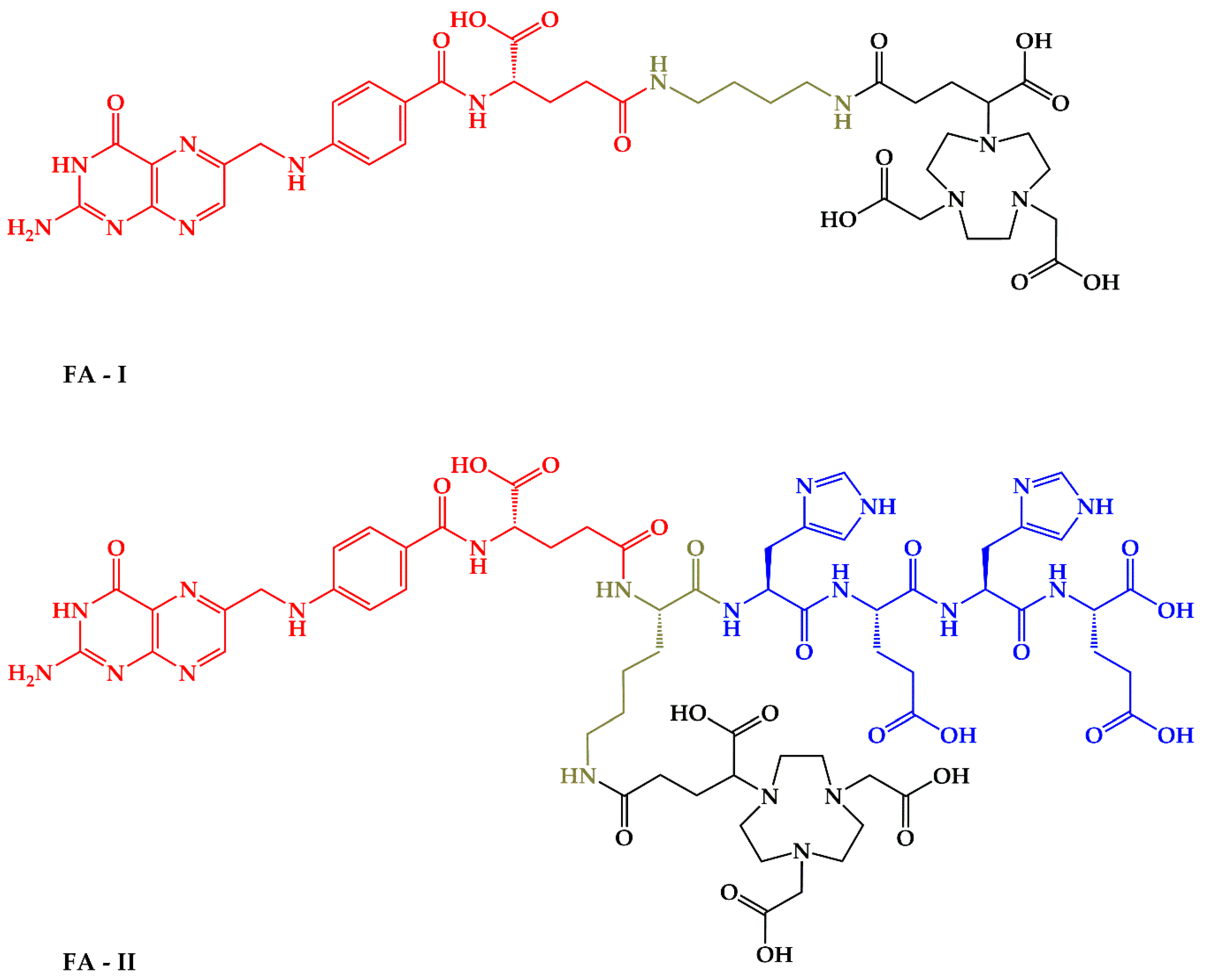
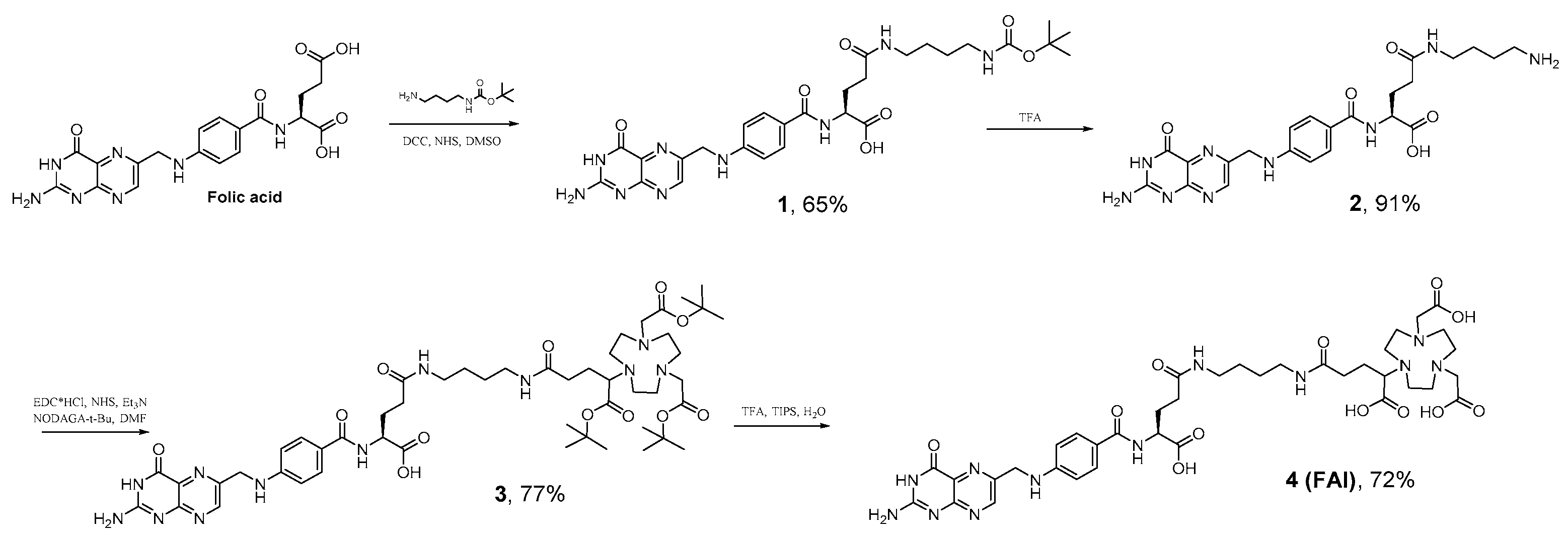
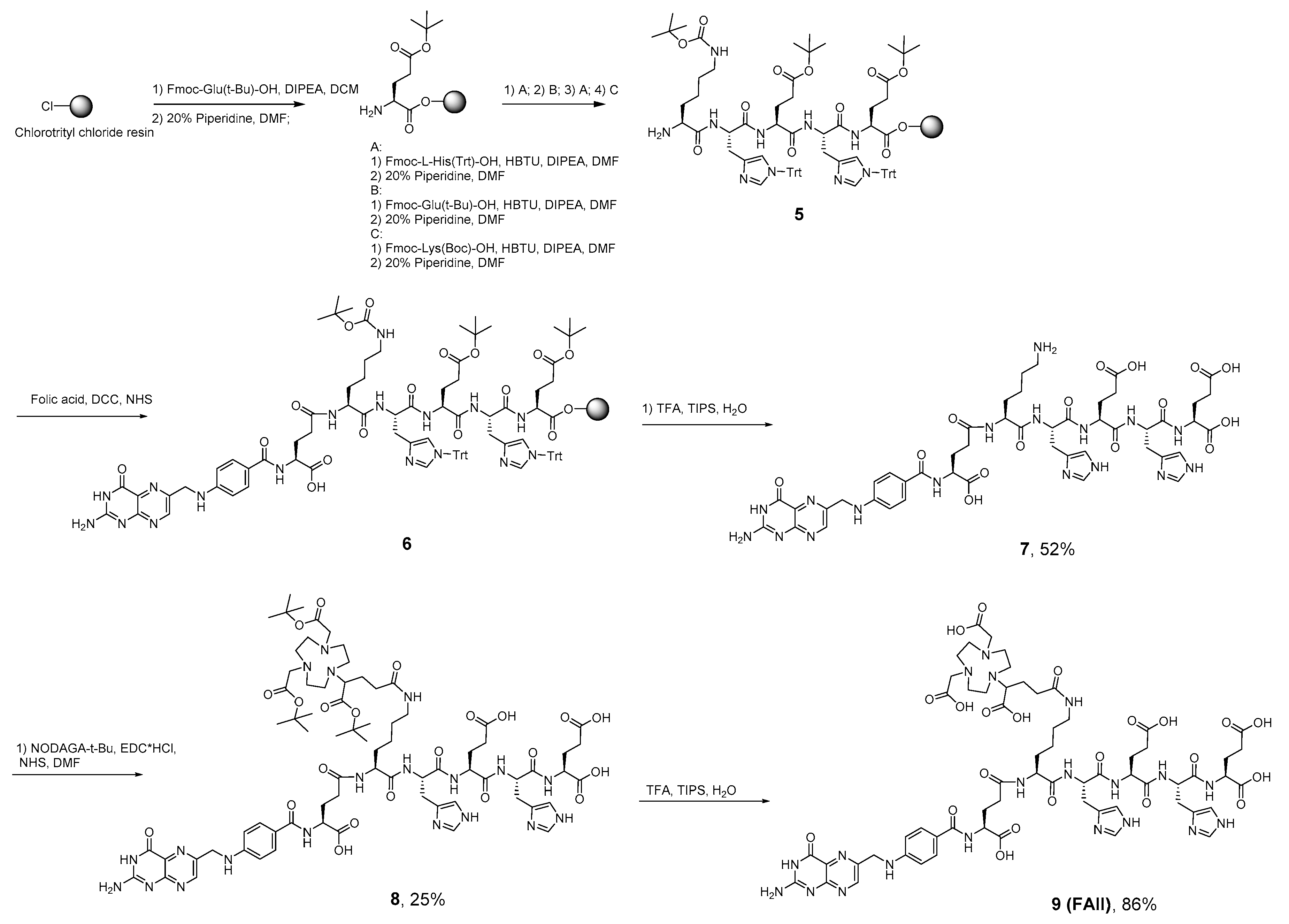


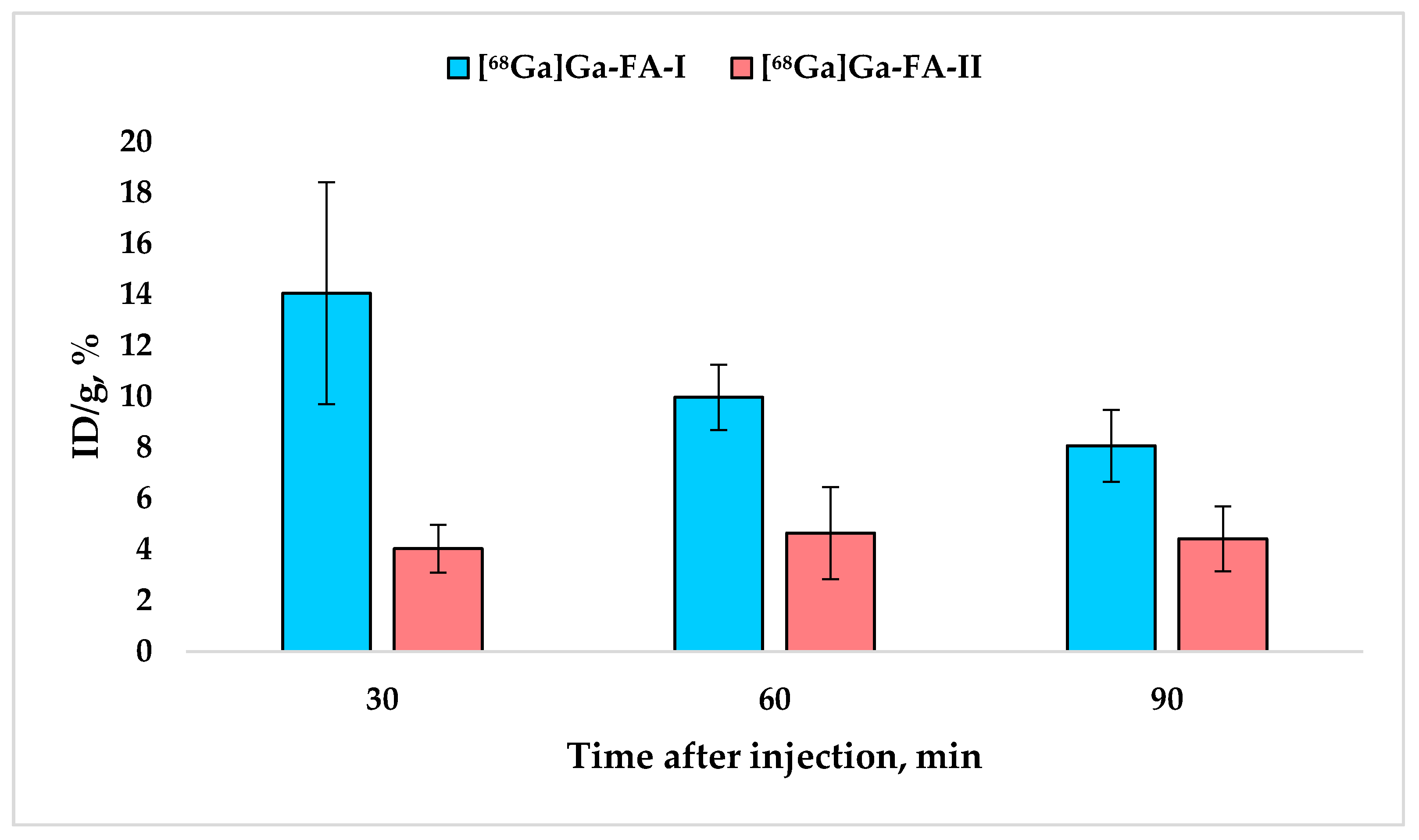

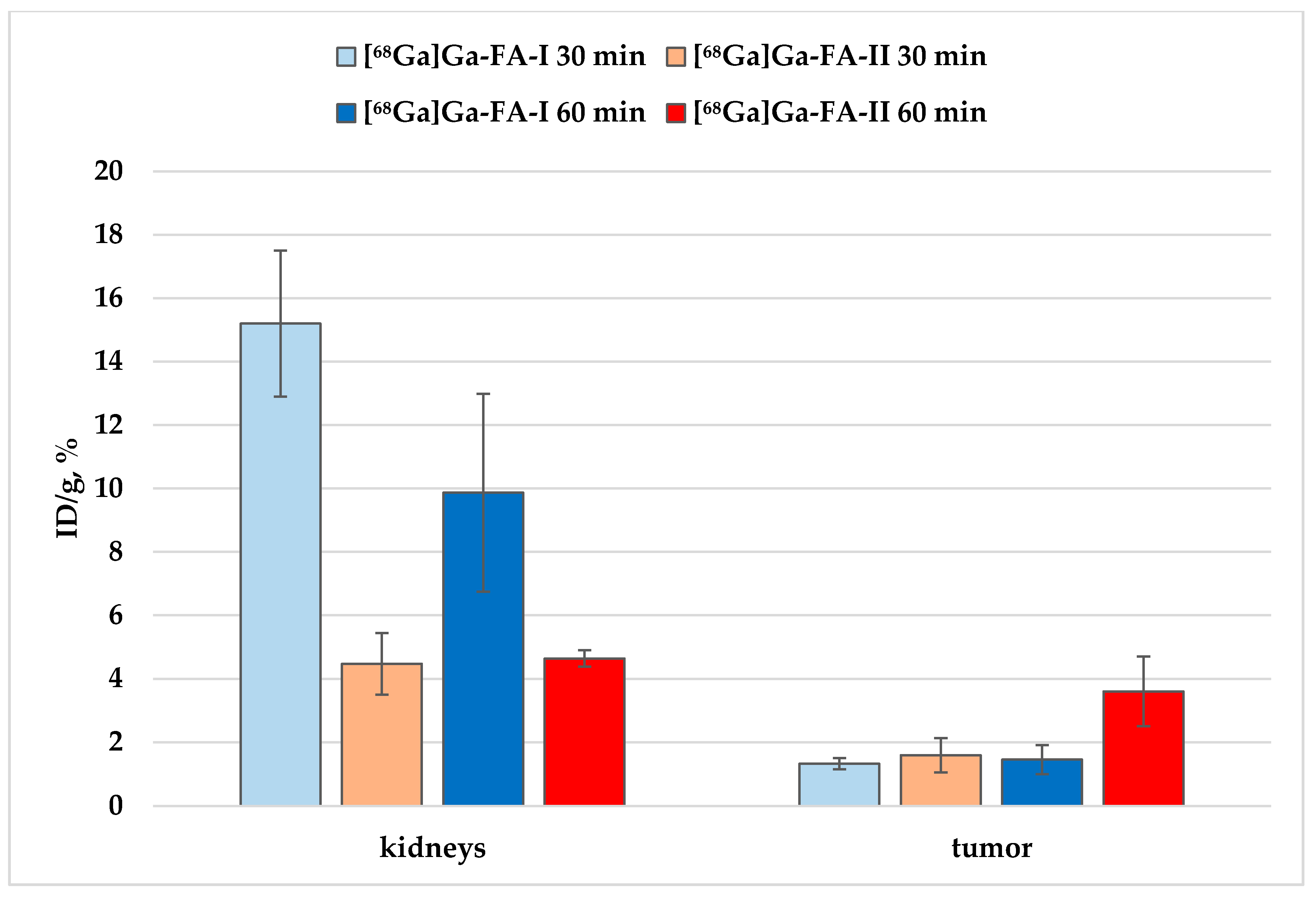
| ID/g,% | ||||||||
|---|---|---|---|---|---|---|---|---|
| 30 min | 60 min | 90 min | 120 min | |||||
| Tissue/ Organ | [68Ga]Ga-FA-I | [68Ga]Ga-FA-II | [68Ga]Ga-FA-I | [68Ga]Ga-FA-II | [68Ga]Ga-FA-I | [68Ga]Ga-FA-II | [68Ga]Ga-FA-I | [68Ga]Ga-FA-II |
| blood | 0.41 ± 0.10 | 0.28 ± 0.03 | 0.26 ± 0.07 | 0.22 ± 0.06 | 0.13 ± 0.03 | 0.09 ± 0.01 | 0.08 ± 0.02 | 0.06 ± 0.02 |
| lungs | 0.46 ± 0.08 | 0.28 ± 0.06 | 0.32 ± 0.09 | 0.24 ± 0.07 | 0.21 ± 0.08 | 0.12 ± 0.02 | 0.24 ± 0.02 | 0.11 ± 0.02 |
| heart | 0.30 ± 0.11 | 0.27 ± 0.07 | 0.28 ± 0.09 | 0.16 ± 0.08 | 0.18 ± 0.12 | 0.10 ± 0.01 | 0.12 ± 0.02 | 0.08 ± 0.01 |
| kidneys | 14.05 ± 4.35 | 4.03 ± 0.94 | 9.97 ± 1.28 | 4.64 ± 1.80 | 8.07 ± 1.41 | 4.42 ± 1.27 | 13.15 ± 1.11 | 4.34 ± 0.18 |
| liver | 0.40 ± 0.09 | 0.18 ± 0.06 | 0.25 ± 0.05 | 0.12 ± 0.06 | 0.19 ± 0.10 | 0.07 ± 0.01 | 0.16 ± 0.03 | 0.05 ± 0.01 |
| stomach | 0.17 ± 0.02 | 0.20 ± 0.02 | 0.14 ± 0.08 | 0.12 ± 0.05 | 0.17 ± 0.04 | 0.11 ± 0.01 | 0.14 ± 0.05 | 0.08 ± 0.04 |
| spleen | 0.16 ± 0.10 | 0.13 ± 0.04 | 0.09 ± 0.01 | 0.07 ± 0.04 | 0.06 ± 0.02 | 0.06 ± 0.02 | 0.09 ± 0.04 | 0.04 ± 0.02 |
| intestines | 0.37 ± 0.13 | 0.08 ± 0.01 | 0.26 ± 0.08 | 0.08 ± 0.02 | 0.31 ± 0.07 | 0.07 ± 0.01 | 0.32 ± 0.16 | 0.12 ± 0.08 |
| bladder | 0.27 ± 0.15 | 0.89 ± 0.80 | 0.36 ± 0.31 | 0.40 ± 0.16 | 0.16 ± 0.01 | 0.27 ± 0.03 | 0.16 ± 0.06 | 0.14 ± 0.02 |
| muscle | 0.29 ± 0.06 | 0.10 ± 0.03 | 0.12 ± 0.05 | 0.06 ± 0.01 | 0.14 ± 0.05 | 0.04 ± 0.01 | 0.11 ± 0.03 | 0.04 ± 0.01 |
| brain | 0.06 ± 0.03 | 0.04 ± 0.01 | 0.04 ± 0.01 | 0.02 ± 0.01 | 0.03 ± 0.01 | 0.02 ± 0.01 | 0.03 ± 0.01 | 0.01 ± 0.01 |
| ID/g,% | ||||
|---|---|---|---|---|
| Organ | [68Ga]Ga-FA-I | [68Ga]Ga-FA-I with Folic Acid Pre-Injection | [68Ga]Ga-FA-II | [68Ga]Ga-FA-II with Folic Acid Pre-Injection |
| kidneys | 10.2 ± 1.3 | 1.05 ± 0.20 | 4.27 ± 0.93 | 1.26 ± 0.24 |
| ID/g,% | ||||
|---|---|---|---|---|
| 30 min | 60 min | |||
| [68Ga]Ga-FA-I | [68Ga]Ga-FA-II | [68Ga]Ga-FA-I | [68Ga]Ga-FA-II | |
| blood | 1.37 ± 0.38 | 1.01 ± 0.02 | 1.40 ± 0.39 | 0.63 ± 0.13 |
| lungs | 1.29 ± 0.27 | 1.16 ± 0.24 | 0.52 ± 0.11 | 0.41 ± 0.15 |
| heart | 0.97 ± 0.07 | 0.62 ± 0.13 | 0.79 ± 0.19 | 0.31 ± 0.13 |
| stomach | 0.61 ± 0.22 | 0.47 ± 0.17 | 0.59 ± 0.26 | 0.58 ± 0.30 |
| spleen | 0.36 ± 0.09 | 0.29 ± 0.13 | 0.22 ± 0.08 | 0.24 ± 0.14 |
| liver | 1.62 ± 0.33 | 0.51 ± 0.13 | 1.08 ± 0.06 | 0.27 ± 0.08 |
| kidneys | 15.2 ± 2.3 | 4.47 ± 0.97 | 9.87 ± 3.12 | 4.64 ± 0.26 |
| bladder | 7.7 ± 2.9 | 1.46 ± 0.53 | 2.6 ± 1.8 | 0.96 ± 0.46 |
| intestines | 1.21 ± 0.42 | 0.46 ± 0.15 | 1.03 ± 0.13 | 0.45 ± 0.13 |
| brain | 0.14 ± 0.08 | 0.09 ± 0.03 | 0.11 ± 0.01 | 0.10 ± 0.03 |
| muscle | 0.25 ± 0.03 | 0.24 ± 0.04 | 0.22 ± 0.03 | 0.14 ± 0.04 |
| ovaries | 0.50 ± 0.16 | 0.47 ± 0.21 | 0.34 ± 0.11 | 0.18 ± 0.01 |
| salivary glands | 0.58 ± 0.22 | 0.47 ± 0.18 | 0.22 ± 0.02 | 0.28 ± 0.08 |
| tumor | 1.32 ± 0.18 | 1.59 ± 0.54 | 1.45 ± 0.46 | 3.6 ± 1.1 |
| T/N | DUR | |||
|---|---|---|---|---|
| 30 min | 60 min | |||
| [68Ga]Ga-FA-I | [68Ga]Ga-FA-II | [68Ga]Ga-FA-I | [68Ga]Ga-FA-II | |
| Tumor-to-kidneys | 0.09 ± 0.03 | 0.39 ± 0.18 | 0.17 ± 0.11 | 0.79 ± 0.28 |
| Tumor-to-muscle | 5.4 ± 1.1 | 7.1 ± 2.8 | 6.9 ± 2.5 | 28.9 ± 13.7 |
| Tumor-to-blood | 1.0 ± 0.4 | 1.6 ± 0.5 | 1.2 ± 0.6 | 6.1 ± 2.5 |
| Molecule * | Cells Per Well | Ligand Amount | Culture Medium | Incubation Temp, °C | Incubation Time, min | Cell-Associated Activity,% | Ref. |
|---|---|---|---|---|---|---|---|
| I | ∼0.5–1.0 × 106 | ∼35 pmol | Folate-free RPMI-1640 | 37 | 30 | 15–17 | [17] |
| II | 0.8–1.0 × 106 | 2.5 pmol | Folate-free RPMI-1640 | 37 | 30–240 | 60–80 | [38] |
| III | ∼1.0 × 106 | 0.15 μM§ | Folate-free RPMI-1640 | 4 | 60 | 1.7 | [39] |
| IV | ∼1.0 × 105 | not specified | DMEM | 37 | 30–120 | 0.25–0.91 | [20] |
| V | ∼1.0 × 106 | 0.1 nmol | Folate-free RPMI-1640 | 37 | 30 | 2.84 | [40] |
| VI | ∼1.0 × 106 | 2.5 pmol | Folate-free RPMI-1640 | 37 | 30–120 | 60–72 | [32] |
| VII | ∼1.0 × 106 | 0.5 nmol | EMEM | 37 | 30–90 | 2.9–3.9 | This work |
| VIII | ∼1.0 × 106 | 0.5 nmol | EMEM | 37 | 30–90 | 1.5–4.1 |
| Molecule * | Time After Injection, h | ID/g,% | Animals Were on Folate-Deficient Diet | Ref. | |||
|---|---|---|---|---|---|---|---|
| Kidneys | Liver | Blood | KB Tumor | ||||
| I | 1 | 19.20 ± 2.59 | 7.52 ± 0.55 | 12.76 ± 1.53 | 9.57 ± 0.97 | + | [17] |
| 4 | 25.23 ± 2.40 | 4.20 ± 1.04 | 6.03 ± 1.11 | 11.92 ± 1.68 | |||
| II | 1 | 82.21 ± 5.53 | 4.88 ± 0.81 | 0.32 ± 0.03 | 11.77 ± 2.76 | + | [38] |
| 4 | 103.01 ± 24.58 | 2.08 ± 0.08 | 0.20 ± 0.04 | 14.29 ± 4.14 | |||
| III | 1 | 15.07 ± 4.1 | 2.07 ± 0.6 | 1.17 ± 0.3 | – | – | [39] |
| IV** | – | – | – | – | – | + | [20] |
| V | 4 | 21.65 ± 1.11 | 0.38 ± 0.08 | 0.07 ± 0.01 | 6.61 ± 1.07 | + | [40] |
| VI | 1 | 91.52 ± 21.05 | 2.58 ± 0.26 | 0.24 ± 0.05 | 16.56 ± 3.67 | + | [32] |
| 4 | 130.31 ± 14.65 | 1.07 ± 0.18 | 0.06 ± 0.01 | 16.29 ± 4.46 | |||
| VII | 1 | 9.87 ± 3.12 | 1.08 ± 0.06 | 1.40 ± 0.39 | 1.45 ± 0.46 | – | This work |
| VIII | 1 | 4.64 ± 0.26 | 0.27 ± 0.08 | 0.63 ± 0.13 | 3.6 ± 1.1 | – | |
© 2020 by the authors. Licensee MDPI, Basel, Switzerland. This article is an open access article distributed under the terms and conditions of the Creative Commons Attribution (CC BY) license (http://creativecommons.org/licenses/by/4.0/).
Share and Cite
Larenkov, A.; Rakhimov, M.; Lunyova, K.; Klementyeva, O.; Maruk, A.; Machulkin, A. Pharmacokinetic Properties of 68Ga-labelled Folic Acid Conjugates: Improvement Using HEHE Tag. Molecules 2020, 25, 2712. https://doi.org/10.3390/molecules25112712
Larenkov A, Rakhimov M, Lunyova K, Klementyeva O, Maruk A, Machulkin A. Pharmacokinetic Properties of 68Ga-labelled Folic Acid Conjugates: Improvement Using HEHE Tag. Molecules. 2020; 25(11):2712. https://doi.org/10.3390/molecules25112712
Chicago/Turabian StyleLarenkov, Anton, Marat Rakhimov, Kristina Lunyova, Olga Klementyeva, Alesya Maruk, and Aleksei Machulkin. 2020. "Pharmacokinetic Properties of 68Ga-labelled Folic Acid Conjugates: Improvement Using HEHE Tag" Molecules 25, no. 11: 2712. https://doi.org/10.3390/molecules25112712
APA StyleLarenkov, A., Rakhimov, M., Lunyova, K., Klementyeva, O., Maruk, A., & Machulkin, A. (2020). Pharmacokinetic Properties of 68Ga-labelled Folic Acid Conjugates: Improvement Using HEHE Tag. Molecules, 25(11), 2712. https://doi.org/10.3390/molecules25112712






